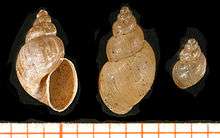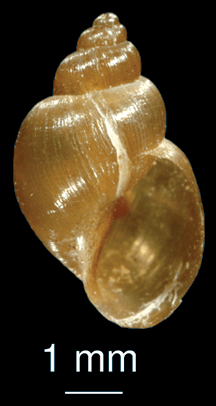Galba truncatula
Galba (Galba) truncatula is a species of air-breathing freshwater snail, an aquatic pulmonate gastropod mollusk in the family Lymnaeidae, the pond snails.[3]
| Galba truncatula | |
|---|---|
 | |
| Shells of Galba truncatula, the scale bar is in mm | |
| Scientific classification | |
| Kingdom: | |
| Phylum: | |
| Class: | |
| (unranked): | |
| Superfamily: | |
| Family: | |
| Subfamily: | Lymnaeinae |
| Genus: | |
| Species: | G. truncatula |
| Binomial name | |
| Galba truncatula (O. F. Müller, 1774)[2] | |
| Synonyms | |
| |
Until recently, this species was known as Lymnaea truncatula.
Galba truncatula is the vector mainly involved in fascioliasis transmission to humans.[4]
Distribution

Galba truncatula is believed to be native to Europe, but it has been introduced in other parts of world.[5] Currently, Galba truncatula is commonly distributed in all European countries, including most Mediterranean islands such as Corsica, Malta, the Azores, Madeira, the Faroe Islands, the Balearic Islands, and the Canary Islands.[1] Despite the fact that Galba truncatula has spread worldwide, exact distribution maps of the species are not available. In addition, most reports are based on morphological determination of the snail. Molecular evidences on the presence of Galba truncatula from non-European areas are limited. Galba truncatula has also been found in North and South America, several parts of Africa, and Asia.[5]
In South America, the presence of Galba truncatula has already been molecularly verified in Bolivia, Peru, Argentina, Chile and Venezuela.[4] In Africa, Galba truncatula is present mainly in Northern parts (i.e. Morocco,[6] Algeria,[7] Tunis,[8] Egypt[9]) but also in South Africa,[10] Ethiopia,[11] Kenya, and Tanzania.[12]
In Asia, the snail occurs in Russia[5] but other Asian countries were reported very rarely. Galba truncatula was found in Iran,[13] Pakistan[14] and India.[1]
Description
The height of the shell is 5–10 mm and the width of the shell is 2.5–6 mm.
The maximum length of the shell is 12.00 mm.[4] Whorls are stepped.[4] The columella is folded.[4]
Tentacles are wider and with a wide base.[4] Eyes are small.[4] Mantle roof shows larger unpigmented whitish spots giving a pale appearance to the shell of living specimens by transparency.[4]
The first bilateral teeth is tricuspid in radula.[4] The praeputium/penis sheath length ratio is 2.50-5.90 mm (mean 3.44 mm).[4]
Two species that have a similar morphology: Galba neotropica and Galba schirazensis.[4] Although several phenotypic characteristics may a priori be helpful for a preliminary specimen classification, a definitive classification of a specimen can only be obtained by the sequencing of at least one of the molecular markers used: ITS-2, ITS-1, 16S and cox1.[4] Moreover, mixed populations of Galba truncatula and Galba schirazensis have already been described in the field.[4]
Ecology
Habitat
Galba truncatula can occupy both temporary and permanent freshwater habitats.[15][16] The species occurs commonly in shallow well aerated water, in marshes, ponds, lakes, streams, rivers, water ditches.[15][17] In France, the populations of Galba truncatula are declining because its habitat is threatened by modern agricultural practices.[18] In case of larger water bodies, the snail occurs mostly on the edge between water and land, sometimes outside water layer on mud.[15] Galba truncatula can be very abundant, with high population densities and it has an evident anthropophily including usual presence in human neighbourhood.[4]
Galba truncatula is amphibious organism and can survive long dry periods. This is caused by its high ability to aestivate during drought conditions. It is known that Galba truncatula can survive 6 weeks to 4.5 months of dry periods in aestivated stage in mud. In the laboratory cultures, Kendall (1949) observed survival over 1 year in Petri dishes without water.[15]
The species requires alkaline pH (pH range 7.0 up to 9.6)[17][19] and calcium content over 0,3 mekv/l.[17]
Galba truncatula can live at a very high altitude such as in the Northern Bolivian Altiplano (an area located between 3800 and 4100 m high altitude).[4]
Life cycle
In Europe, it has usually 2 generations per year and snails can live up to 2 years.[21] During very wet years, the species can produce occasionally 3 generations per year.[22]
They are hatching from eggs. The shape of egg cluster is rounded to oval shape even when containing more eggs.[4] There are usually 2-15 eggs in cluster.[4]
Parasites
Galba truncatula is an intermediate host for these known trematodes and nematodes:
- Fasciola hepatica[5]
- Fasciola gigantica[23]
- Fascioloides magna[24]
- Haplometra cylindracea[25]
- Plagiorchis spp.[26]
- Opisthioglyphe spp.[26]
- Calicophoron daubneyi[27]
- Muellerius capillaris[28]
Transmission capacity of fascioliasis to humans and to animals is high.[4]
References
This article incorporates CC-BY-2.0 text from the reference[4]
- Madhyastha A. (2010). Galba truncatula. In: IUCN 2012. IUCN Red List of Threatened Species. Version 2012.1. <www.iucnredlist.org>. Downloaded on 16 September 2012.
- Müller, O. F. 1774. Vermivm terrestrium et fluviatilium, seu animalium infusoriorum, helminthicorum, et testaceorum, non marinorum, succincta historia. Volumen alterum. - pp. I-XXVI [= 1-36], 1-214, [1-10]. Havniae & Lipsiae. (Heineck & Faber).
- Neubauer, Thomas A. (2014). Galba (Galba) truncatula (Müller, 1774). Accessed through: World Register of Marine Species at http://www.marinespecies.org/aphia.php?p=taxdetails&id=822446 on 2014-11-17
- Bargues MD, Artigas P, Khoubbane M, Ortiz P, Naquira C, Mas-Coma S (2012). "Molecular characterisation of Galba truncatula, Lymnaea neotropica and L. schirazensis from Cajamarca, Peru and their potential role in transmission of human and animal fascioliasis". Parasites & Vectors. 5: 174. doi:10.1186/1756-3305-5-174.
- Mas-Coma S, Bargues MD, Valero MA (October 2005). "Fascioliasis and other plant-borne trematode zoonoses". Int. J. Parasitol. 35 (11–12): 1255–78. doi:10.1016/j.ijpara.2005.07.010. PMID 16150452.
- Khallaayoune K, Stromberg BE, Dakkak A, Malone JB (June 1991). "Seasonal dynamics of Fasciola hepatica burdens in grazing Timahdit sheep in Morocco". Int. J. Parasitol. 21 (3): 307–14. doi:10.1016/0020-7519(91)90032-3. PMID 1894428.
- Mekroud A, Benakhla A, Vignoles P, Rondelaud D, Dreyfuss G (April 2004). "Preliminary studies on the prevalences of natural fasciolosis in cattle, sheep, and the host snail (Galba truncatula) in north-eastern Algeria". Parasitol. Res. 92 (6): 502–5. doi:10.1007/s00436-004-1072-1. PMID 14999466.
- Hammami H, Ayadi A (2000). "[Natural infestation of Lymnaea truncatula Muller by Fasciola hepatica in the Tozeur oasis in southwest Tunisia]". Med Trop (Mars) (in French). 60 (2): 159–62. PMID 11100443.
- Dar Y, Rondelaud D, Dreyfuss G (February 2003). "Cercarial shedding from Galba truncatula infected with Fasciola gigantica of distinct geographic origins". Parasitol. Res. 89 (3): 185–7. doi:10.1007/s00436-002-0732-2. PMID 12541059.
- de Kock KN, Wolmarans CT, Bornman M (December 2003). "Distribution and habitats of the snail Lymnaea truncatula, intermediate host of the liver fluke Fasciola hepatica, in South Africa". J S Afr Vet Assoc. 74 (4): 117–22. doi:10.4102/jsava.v74i4.523. PMID 15038424.
- Goll PH, Scott JM (1978). "The interrelationship of Lymnaea truncatula and ovine fascioliasis in the Ethiopian Central Highlands". Br. Vet. J. 134 (6): 551–5. doi:10.1016/S0007-1935(17)33336-5. PMID 719517.
- Walker SM, Makundi AE, Namuba FV, et al. (April 2008). "The distribution of Fasciola hepatica and Fasciola gigantica within southern Tanzania--constraints associated with the intermediate host". Parasitology. 135 (4): 495–503. doi:10.1017/S0031182007004076. PMID 18205983.
- Glöer P, Pešić V (2012). "The freshwater snails (Gastropoda) of Iran, with descriptions of two new genera and eight new species". ZooKeys (219): 11–61. doi:10.3897/zookeys.219.3406. PMC 3433696. PMID 22977349.
- Kendall SB (1965). Relationships between the species of Fasciola and their molluscan hosts. Adv. Parasitol. Advances in Parasitology. 3. pp. 59–98. doi:10.1016/s0065-308x(08)60363-2. ISBN 9780120317035. PMID 5334822.
- Kendall SB (1949). "Bionomics of Limnaea truncatula and the parthenite of Fasciola hepatica under drought conditions". J. Helminthol. 23 (1–2): 57–68. doi:10.1017/s0022149x00032375.
- Chapuis E, Trouve S, Facon B, Degen L, Goudet J (August 2007). "High quantitative and no molecular differentiation of a freshwater snail (Galba truncatula) between temporary and permanent water habitats" (PDF). Mol. Ecol. 16 (16): 3484–96. doi:10.1111/j.1365-294X.2007.03386.x. PMID 17688547.
- Glöer P. (2002). Überfamilie Lymnaeoidea Rafinesque 1815. Familie Lymnaeidae Lamarck 1812. In: Glöer P. (ed.) Die Süßwassergastropoden Nord-und Mitteleuropas. Bestimmungschlüssel, Lebensweise, Verbreitung. Die Tierwelt Deutschlands 73. Conchbooks, Hackenheim, pp. 200–232.
- Dreyfuss, Gilles; Vignoles, Philippe; Rondelaud, Daniel (2016). "Current decline in the number and size of Galba truncatula and Omphiscola glabra populations, intermediate hosts of Fasciola hepatica, on the acidic soils of Central France". Parasite. 23: 46. doi:10.1051/parasite/2016055. PMC 5086825. PMID 27774956.

- (in Swedish) Nilsson C., Ericsson U., Medin M., Sundberg I. (1998). Sötvattenssnäckor i södra Sverige – en jämförelse med 1940-talet. Naturvårdsverket Rapport 4903.
- (in Czech) Beran L. (1998) Vodní měkkýši ČR. Metodika ČSOP 17, ČSOP Vlašim, 113 pp.
- (in Polish) Jackiewicz M. (2000). Blotniarky Europy (Gastropoda: Pulmonata: Lymnaeidae). Wydawnictwo Kontekst, Poznań. 115 pp.
- Mekroud A, Benakha A, Benlatreche C, Rondelaud D, Dreyfuss G (2002). "First studies on the habitats of Galba truncatula (Mollusca Gastropoda : Lymnaeidae), the snail host of Fasciola hepatica, and the dynamics of snail populations in Northeastern Algeria" (PDF). Revue Méd. Vét. 153 (3): 181–188.
- Dar Y, Vignoles P, Rondelaud D, Dreyfuss G (September 2004). "Larval productivity of Fasciola gigantica in two lymnaeid snails". J. Helminthol. 78 (3): 215–8. doi:10.1079/joh2003224. PMID 15469623.
- Vignoles P, Novobilský A, Rondelaud D, et al. (April 2006). "Cercarial production of Fascioloides magna in the snail Galba truncatula (Gastropoda: Lymnaeidae)". Parasitol. Res. 98 (5): 462–7. doi:10.1007/s00436-005-0077-8. PMID 16416118.
- Vignoles P, Rondelaud D, Dreyfuss G (May 2007). "The populations of Galba truncatula, known for their natural infections with Haplometra cylindracea (Digenea, Plagiorchioidea), are better intermediate hosts for metacercarial production of Fasciola hepatica". Parasitol. Res. 100 (6): 1371–3. doi:10.1007/s00436-006-0387-5. PMID 17149602.
- "GALBA TRUNCATULA (MULLER, 1774). A FACTOR FOR SPREADING OF FASCIOLOSIS" (PDF). Retrieved 2012-08-20.
- Dreyfuss G, Vignoles P, Rondelaud D (July 2008). "Paramphistomum daubneyi: the number of sporocysts developing in experimentally and naturally infected Galba truncatula". Parasitol. Res. 103 (2): 345–9. doi:10.1007/s00436-008-0978-4. PMID 18470698.
- Hourdin P, Rondelaud D, Cabaret J (April 1993). "The development of Fasciola hepatica parthenitae in Lymnaea truncatula by modification of Muellerius capillaris infection". Int. J. Parasitol. 23 (2): 235–43. doi:10.1016/0020-7519(93)90146-p. PMID 8496006.
Further reading
- Chapuis E (2009). "Correlation between parasite prevalence and adult size in a trematode-mollusc system: evidence for evolutionary gigantism in the freshwater snail Galba truncatula?" (PDF). Journal of Molluscan Studies. 75 (4): 391–396. doi:10.1093/mollus/eyp035.
- Trouve S, Degen L, Goudet J (2005). "Ecological components and evolution of selfing in the freshwater snail Galba truncatula". Journal of Evolutionary Biology. 18 (2): 358–370. doi:10.1111/j.1420-9101.2004.00831.x. PMID 15715842.
- D. Rondelaud and C. Vareille-Morel, The chemical and biological control of Lymnaea truncatula in natural watercress beds in the Limousin region (France); Parasite Volume 1, Number 1, March 1994
- Dreyfuss G, Rondelaud D (1997). "Les habitats de Lymnaea truncatula Müller (Mollusque) le long de deux rivières". Annales de Limnologie - International Journal of Limnology. 33 (2): 67–72. doi:10.1051/limn/1997009.
External links
| Wikimedia Commons has media related to Galba truncatula. |
- Galba truncatula at Animalbase taxonomy, short description, distribution, biology, status (threats), images
